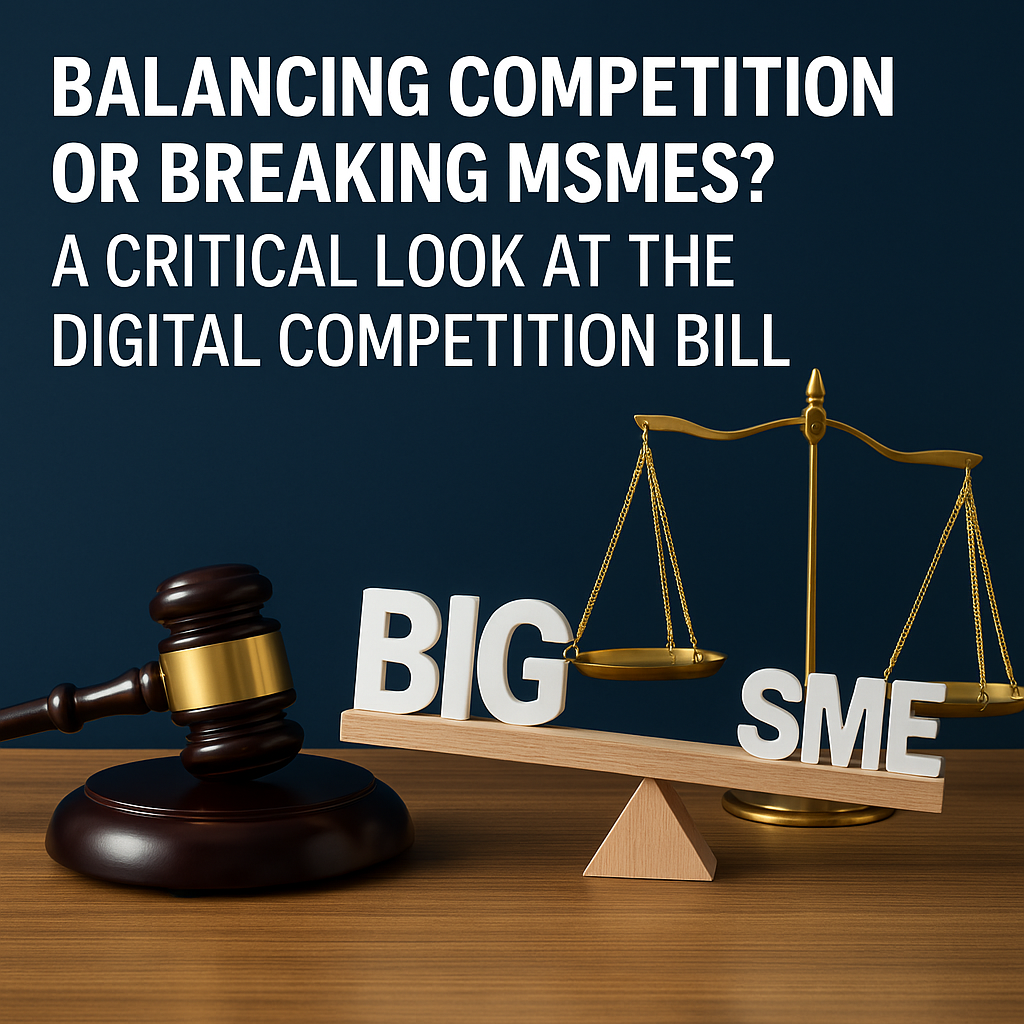|
Powered by AltAlpha AI
|
[“Shanaya Singh and Prince Raj are 3rd year students at Gujarat National Law University, Gandhinagar”]
Introduction
Recently, investigations into big tech farms have become synonymous with global competition law, and regulators have increasingly shifted from passive enforcement to active enforcement. India, too, is a part of this movement to change tack, particularly through the Competition Commission of India’s (“CCI”) stance on digital markets. In May 2025, the CCI agreed to Google’s offer of ₹202.4 million settlement of a case of abuse of dominance involving Google’s Android TV platform; this is not just any other legal enforcement action but India’s first digital market settlement under the amended Competition Act, 2023. It asserts a firm step towards possible negotiated remedies and flexible enforcement, while at the same time, it also shows the CCI’s willingness to apply a modern tool of regulation in handling complicated digital setups with evolving technology. Through this article, the authors aim to address the amended legal framework, the details of the Google-Android TV case and the wider significance of India’s antitrust enforcement on this remarkable turn.
Background of the Case
This agreement arises from charges relating to Google’s market dominance in the Android TV operating system space, a market where the technology giant has replicated its widespread influence on mobile devices. Just as in the case of smartphones, Google was charged with forcing Original Equipment Manufacturers (“OEMs”) to pre-install its set of applications, such as YouTube and Play Store and include Google Search as a default, subject to the requirement that they access vital platform services.
In turn, CCI opened a prima facie inquiry under Section 26 (1), indicating probable abuse of dominance under Section 4. This case is uncannily similar to CCI’s order of 2022 in the Android mobile OS case, where a fine of INR 1,337 crore was levied on Google for similar tying and exclusivity strategies. However, what differentiates the Android TV issue is “the change of procedure”. Instead of dragging the case through extended traditional legal proceedings, Google approached CCI under the newly established settlement process (Sections 48A), a development which not just illustrates a transformation in the enforcement dynamics but also represents the tactical realignment by the accused to mitigate any reputational or regulatory risk.
Legal Frameworks and Key Obligations in the Google-Android TV Settlement
This settlement is effectuated on the basis of the Competition (Amendment) Act, 2023, which added Section 48A enabling settlements and commitments in antitrust proceedings that were a long-awaited procedural reform and in line with international enforcement standards. As per Section 48A, an enterprise can make a settlement prior to the filing of the Director General’s investigation report. These frameworks are intended to encourage speedy resolutions to disputes and reduce the litigation burden via encouraged compliance through mutual cooperation. The procedure has certain specific timelines, disclosures before the CCI, and third-party/public comment opportunities, thus blending regulatory expediency with procedural openness. The Android TV matter marks CCI’s first application of these provisions in the digital economy, a critical stress test for the new regime. This is a very crucial step as it signals the Commission’s willingness to explore negotiated solutions even in complex digital markets, which render traditional punitive measures mostly impotent; to infuse, in a timely manner, an outcome that is either corrective or satisfactory. The CCI thereby took a calculated and decisive step into the adaptation of the Indian competition law framework.
Further, CCI in May 2025 imposed a penalty of INR 20.24 crore on Google through a settlement order. This is significant as it is not an admission but a regulatory settlement which indicates the desire of the commission to trade off full adjudication for prospective market rectification. The redacted public version of the order underlines various non-monetary commitments as the essence of the resolution. Under the settlement, Google promised to grant OEMs more freedom under contracts such as having the power to pre-load rival app stores on smart TVs without being subject to retaliatory measures. It also promised to unbundle YouTube and Google Play Services from the Android TV licensing model, specifically addressing a central charge that so-called tying practices misrepresent consumer and developer choice. In addition, Google also committed to providing open access to major APIs, allowing third-party developers to create interoperable applications competing with the Google ecosystem. Such obligations have a period of three years during which the competition authority shall be entitled to monitor the compliance thereof, either through inspections by a third party or progress reports. This solution signals a trend towards behavioural remedies as opposed to structural fines, which fits the regulatory sanction into the complexity of the digital market and the demand for a speedy response.
Global Parallels and the Future of Big Tech Enforcement in India
The Google-Android TV settlement is not just a mere solo regulatory move, it is one of the landmark instances in a rising global trend for much flexibility and remedy-based enforcement in digital economies. Seminal instances such as the Google Shopping and Android mobile OS cases were solved using structural and behavioural commitments accepted to restore market equilibrium more quickly than the litigation process. Earlier, such commitments were traditionally met by the EU countries, where the Article 9 (Regulation 1/300) decision would require a firm to voluntarily offer potential remedies to competition issues on the premise that, “they are not admitting any fault”.
In contrast, the U.S. DOJ is hesitant and discourages such settlements, preferring structural remedies and full trials in cases of entrenched monopolistic practices, thereby favouring the constitution of precedents by jurisprudence rather than negotiated compliance. However, India traditionally takes an adversarial approach to antitrust enforcement and is currently in the process of restructuring the institutional procedure. The Android TV settlement stands as the foremost example of this change, expanding on prior settlements in pharma cartel matters and now applying it to a disruptive digital setup where certainty in law exists with utmost value on a speedy intervention. As the new regulation brings significant efficiencies, settlement processes eliminate uncertainty and over-compliance, enabling companies to correct behaviour without long litigation and implement corrective action in real time, which is very critical in rapidly evolving tech markets. From a compliance perspective, it also promotes proactive interaction with the regulator, a development that might be attractive to international technology companies looking at India as a strategic jurisdiction.
This development, though, can also be risky. Critics wonder if an INR 20.24 crore fine is an adequate deterrent for a company as giant as Google. The worry is that settlements can be viewed as a regulatory weakness and not accountability. Therefore, the key for CCI will be to preserve a credible threat of enforcement in addition to this flexibility in order to not be viewed as a soft regulator. Nonetheless, the larger message shines through, ‘India is repositioning not only as an enforcement jurisdiction but as a standard-setter in international digital competition law’ and the Google-Android TV serves as a template for how India strikes the balance between enforcement and market sensitivity in its subsequent interactions with Big Tech”.
Conclusion
While marking the landmark instance within the Competition Law in India “Google-Android TV settlement” represents the very first-ever case of digital market abuse to be settled through a settlement as against the regressive litigation procedure. It also shows the reflection of CCI’s evolving and adaptive approach in dealing with changing and complex tech ecosystems, preferring speed and market correction over procedural rigidity. Though, it raises a crucial questions that, ‘Will these agreements dimnish deterrence or will make the enforcement system more flexible?’ As Big Tech starts to carve its mark on India’s digital economy, the hybrid model shall be tested during the upcoming years if “it can resolve incentives towards complying with regulatory power or not”. In any case, this Android TV case has significantly redefined antitrust’s boundaries in India.






